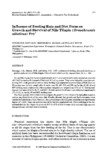| dc.contributor.author | Agpoon, Irish Emmanuel P. | |
| dc.contributor.author | Aya, Frolan | |
| dc.contributor.author | Watanabe, Kenshi | |
| dc.contributor.author | Bennett, Reuel M. | |
| dc.contributor.author | Aki, Tsunehiro | |
| dc.contributor.author | Dedeles, Gina | |
| dc.date.accessioned | 2024-06-28T08:37:38Z | |
| dc.date.available | 2024-06-28T08:37:38Z | |
| dc.date.issued | 2024-06 | |
| dc.identifier.citation | Agpoon, I. E. P., Aya, F. A., Watanabe, K., Bennett, R. M., Aki, T., & Dedeles, G. R. (2024). Pichia kudriavzevii as feed additive in Nile tilapia (Oreochromis niloticus) diet. Letters in Applied Microbiology, 77(6), ovae057. https://doi.org/10.1093/lambio/ovae057 | en |
| dc.identifier.issn | 0266-8254 | |
| dc.identifier.uri | http://hdl.handle.net/10862/6540 | |
| dc.description.abstract | Yeasts are unicellular eukaryotic microorganisms extensively employed in various applications, notably as an alternative source of protein in feeds, owing to their nutritional benefits. Despite their potential, marine and mangrove yeast species used in the aquaculture industry have received little attention in the Philippines. Pichia kudriavzevii (A2B R1 ISO 3), sourced from bark samples, was selected and mass-produced due to its high protein content and amino acid profile. The dried biomass of P. kudriavzevii was incorporated into the diets of Nile tilapia (Oreochromis niloticus) juveniles at varying inclusion levels (0, 1, 2, and 4 g/kg diet) and its effect on their growth performance, body composition, and liver and intestinal morphology was assessed after 40 days of feeding. The groups that received P. kudriavzevii at a concentration of 2 g/kg diet exhibited higher final body weight, percent weight gain, and specific growth rate in comparison to the other treatment groups. Whole body proximate composition did not vary among the dietary groups. Intestinal and liver histopathology also indicated no abnormalities. These findings suggest the potential of ascomycetous P. kudriavzevii as a beneficial feed additive in Nile tilapia diets, warranting further investigation into its long-term effects and broader applications in fish culture. | en |
| dc.description.sponsorship | Department of Science and Technology—Accelerated Science and Technology Human Resource Development Program (DOST-ASTHRDP), National Research Council of the Philippines—Project E-250, University of Santo Tomas, Research Center for the Natural and Applied Sciences, Southeast Asian Fisheries Development Center—Aquaculture Department (SEAFDEC/AQD), and the Government of Japan—Trust Fund (8300-B-RD-FD0120). | en |
| dc.language.iso | en | en |
| dc.publisher | Oxford University Press | en |
| dc.publisher | Applied Microbiology International | en |
| dc.subject | Oreochromis niloticus | en |
| dc.subject | tilapia | en |
| dc.title | Pichia kudriavzevii as feed additive in Nile tilapia (Oreochromis niloticus) diet | en |
| dc.type | Article | en |
| dc.citation.volume | 77 | en |
| dc.citation.issue | 6 | en |
| dc.citation.spage | ovae057 | en |
| dc.citation.journalTitle | Letters in Applied Microbiology | en |
| dc.subject.asfa | feed additives | en |
| dc.subject.asfa | diet | en |
| dc.subject.asfa | yeasts | en |
| dc.subject.asfa | feeding | en |
| dc.subject.asfa | tilapia culture | en |
| dc.subject.asfa | amino acids | en |
| dc.subject.asfa | glycine (amino acid) | en |
| dc.subject.asfa | biomass | en |
| dc.subject.asfa | histopathology | en |
| dc.identifier.essn | 1472-765X | |
| dc.identifier.doi | 10.1093/lambio/ovae057 | |
| dc.subject.scientificName | Pichia kudriavzevii | en |
| dc.subject.scientificName | Oreochromis niloticus | en |
| local.subject | mangrove yeasts | en |
| local.subject | proteins | en |
| local.subject | Pichia kudriavzevii | en |
| local.subject | Oreochromis niloticus | en |



